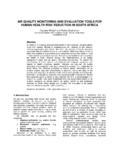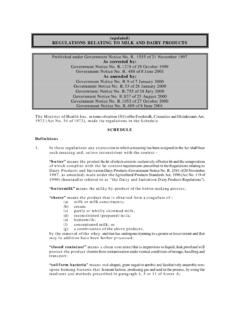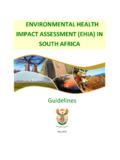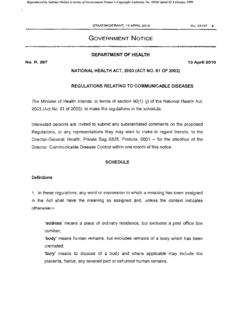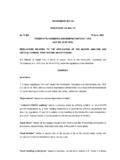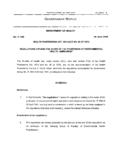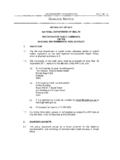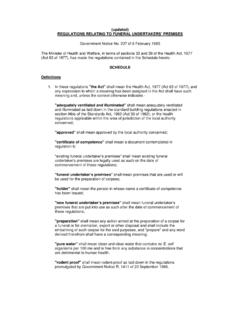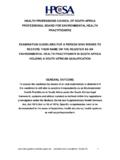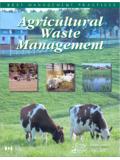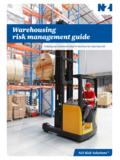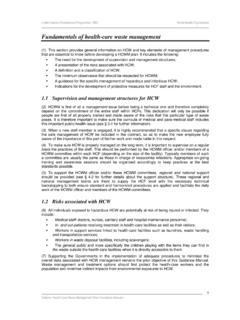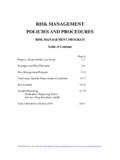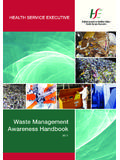Transcription of A WASTE MANAGEMENT BEST PRACTICE …
1 A WASTE MANAGEMENT best PRACTICE example BY environmental HEALTH: SOUTH AFRICA Mike Agenbag Cape Peninsula University of Technology PO Box 652, Cape Town, 8000, South Africa; Tel: +27 (0)21 460 3206; e-mail, Overview Abstract Background environmental health challenges that impact on WASTE MANAGEMENT Method WASTE MANAGEMENT system, tools and approach Figure 1: MHS WASTE Monitoring Approach Figure 2: Monitoring & Evaluation Tools Dashboard Pictorial report Figure 3: Time Line Summary / Overview Figure 4: Integrated Performance MANAGEMENT System - Efficiency Register? Findings Conclusion Boxes Box 1a-e: WASTE MANAGEMENT challenges Box 2: Case Study Box 3: Scope of the profession: WASTE MANAGEMENT 2 WASTE MANAGEMENT best PRACTICE EHS Agenbag - 2014 Abstract WASTE MANAGEMENT in South Africa is regulated by various legislation and different role-players, including environmental health services (EHS) (know at local government level as Municipal Health Services [MHS]) at Metropolitan and District Municipalities.
2 Although MHS is classified by government as a basic service, together with WASTE and other key municipal services, government is not supporting MHS appropriately to ensure effective WASTE MANAGEMENT services to communities in order to prevent associated ill health burden to the country s health system. MHS lacks standardised systems, guidelines and tools to ensure proper WASTE MANAGEMENT implementation and coordination to prevent ill health and any negative environmental impacts. Poor WASTE MANAGEMENT practices have resultant effects to our communities and the environments we live in . The MHS section at a district municipality in the Eastern Cape Province embraced its legal mandate and developed programmes according to the legislative prescribes to address the environmental health risks in the district associated with WASTE . Amongst others the MHS section developed a systematic risk MANAGEMENT approach and standardized monitoring tools, systems and routines which optimized the use of resources and alleviated WASTE challenges in the district.
3 3 WASTE MANAGEMENT best PRACTICE EHS Agenbag - 2014 Background The primary objective of EHS is to ensure a safe & healthy environment and to prevent people from getting into health facilities due to preventable diseases [1 - 8]; MHS is a fundamental component of public health, but is rendered at a municipal level and as a result does not get sufficient support from either the National Department of Health nor the Department of Local Government [8 - 13]. Large scale urbanisation without appropriate adjustment for the growing need in WASTE and sanitation services results in poor and unhygienic environmental conditions which has a direct impact on the burden of disease for a region and the country (BOX 1) [1, 7, 8, 14, 15]. environmental health services (EHS) originated as result of these appalling living & working conditions during ancient times, but are still struggling to emphasise the urgency and need for addressing WASTE related challenges as a preventive measure in reducing the burden of diseases to the country s health system and basic service delivery agenda and it is mostly affecting the poor (BOXs 1 and 2) [5 7].
4 4 WASTE MANAGEMENT best PRACTICE EHS Agenbag - 2014 Background (Cont.) With the enactment of the Constitution of the RSA (Act 108 of 1996) and the subsequent legislation, the function for the rendering of MHS were allocated to Metropolitan and District Municipalities and it entails amongst others the functions for WASTE MANAGEMENT , environmental pollution and vector control [8 12]. The Scope of the Profession of environmental Health (Reg. 968 of 2009) clarifies the exact activities that the EHPs are responsible for, amongst others, WASTE MANAGEMENT (BOX 3) [16]. Legislation also regulates the orderly planning IDP and the appropriate implementation of municipal services (SDBIP and PMS) [12, 13, 17]. 5 WASTE MANAGEMENT best PRACTICE EHS Agenbag - 2014 environmental health challenges that impact on WASTE MANAGEMENT EHS in SA mainly approaching and deliver their work on an ad-hoc basis, which does not support the risk and project based approach to optimise the available resources to address the real environmental health risks appropriately [2, 18].
5 Lack of standardised service delivery systems (tools, procedures and routines) [2, 8, 12]. Lack of support and integration from government institutions [12, 13, 19]. High environmental health practitioner (EHP) staff turnover skills and experience retention challenges in especially rural settings [1, 3, 19]. Poor WASTE MANAGEMENT practices (storage, collection and disposal) at local municipalities [8, 19]. WASTE services not a priority for most municipalities, which affects its budgets and other resource allocations to sustainably support the service (8, 19, 22]. As a result it contributes to the filthy environmental conditions that sustain the burden of disease and increase the rehabilitation costs [8, 19, 22]. This resulted in the District Municipality to implement a structured approach that are aligned with all the relevant available information to optimise their limited resources in order to address, amongst others their WASTE MANAGEMENT challenges in the area with their limited resources [19, 23].)
6 6 WASTE MANAGEMENT best PRACTICE EHS Agenbag - 2014 Method The MHS Section embraced their legal as well as professional mandate and developed a strategic plan, which is aligned to the IDP (Integrated Development Plan), SDBIP (Service Delivery, Budget Implementation Plan) and the Performance MANAGEMENT System (PMS), which amongst others prioritised WASTE MANAGEMENT to address the associated challenges in a sustainable way [19]. Due to limited resources they applied Project MANAGEMENT Principles [19, 23] They prioritised their functions and activities, based on the Pareto Principle (80/20 or 90/10), therefore, focusing on issues with biggest impact on the health of the communities ( water, sanitation and WASTE ) [8, 19, 23] The WASTE MANAGEMENT approach specifically focuses on the monitoring, evaluation and control of only two manageable functions [19] Landfill site conditions and Illegal (indiscriminate) WASTE dumping sites (points) as priority WASTE interventions in the respective communities.
7 Standardised systems and monitoring tools were designed and implemented and commitment to the appropriate use were ensured [19] Information gained from the regular monitoring program were communicated to relevant role-players that should addressing the challenges [19]. The monitoring tools were put in use to inform MANAGEMENT decisions for directing limited resources to the areas of greatest need [19]. 7 WASTE MANAGEMENT best PRACTICE EHS Agenbag - 2014 WASTE MANAGEMENT system, tools and approach A WASTE MANAGEMENT protocol were developed, which guided the standardised approach in WASTE MANAGEMENT in the area (Fig. 1). A specialised WASTE Coordinator (Champion) for the MHS Unit were nominated to facilitate the WASTE MANAGEMENT program for the entire district. All the MHS staff were capacitated to ensure they know what is expected of them, with very specific arrangements what they must do, when, where and how.
8 It was ensured that EHPs had to know their area: Identify all the WASTE related risks list all formal (permitted & unpermitted) landfill sites as well as all indiscriminate / illegal WASTE sites in communities. Deal with it by plotting it on the town layout map visual display and visit them weekly, using the monitoring tools. EHPs must compile weekly pictorial reports of the landfill and indiscriminate dumping sites (Fig. 2), Interpret results of findings per site and indicate status of sites on the prescribed time-line (Fig. 3). Follow communication lines and provide weekly status reports (pictorial report and time-lines) to relevant role-players (local municipality WASTE units and MANAGEMENT ) for remedial action (Fig. 1). Monitor submission of weekly reports to role-players for remedial action (Fig. 4). Integrate said reports in monthly MANAGEMENT reports and performance MANAGEMENT system to inform IDP (Integrated Development Plan) and SDBIP (Service, delivery, budget implementation plan) targets (KPAs [Key performance areas] and KPIs [indicators]) (Fig.)
9 1). 8 WASTE MANAGEMENT best PRACTICE EHS Agenbag - 2014 Figure 1: MHS WASTE Monitoring Approach EHP Monitor Weekly (S)EHP Summarises Time-line from pictorial report MHS Managers Office Local Municipality Specialised Coordinators Monthly Reports / Top MANAGEMENT / PMS / Council and Audit Landfill site Indiscriminate WASTE dumping site Pictorial report and time-line Integrated performance efficiency register 9 WASTE MANAGEMENT best PRACTICE EHS Agenbag - 2014 Figure 2: Monitoring & Evaluation Tools Dashboard Pictorial report Showing monitoring sites that corresponds with information on town lay-out map and situation in field. Depict weekly status of sampling point per town (short description and photo) Date of visit To measure is to know 10 WASTE MANAGEMENT best PRACTICE EHS Agenbag - 2014 Figure 3: Time Line Summary / Overview Time-line represents a financial year. Divided into weekly increments to capture weekly status for each landfill and indiscriminate WASTE site in a particular community and area.
10 To measure is to know 11 WASTE MANAGEMENT best PRACTICE EHS Agenbag - 2014 Figure 4: Integrated Performance MANAGEMENT System - Efficiency Register? To measure is to know Monitor if landfill and indiscriminate WASTE site information for each area (local municipality jurisdiction) were sent to relevant role-players who should take remedial action, as prescribed by the protocol. 12 WASTE MANAGEMENT best PRACTICE EHS Agenbag - 2014 Findings Managers do not have time to read each weeks or monthly detailed reports, therefore summary on the time-line give a quick dashboard impression of areas with greatest need to direct institutional effort and resources ( technical services and other departments responsible for addressing the challenges). Intervention benefit the entire institution s efficiency, pro-active response and improve cost effectiveness of service delivery. To p MANAGEMENT became more aware of the extent of WASTE challenges and better support associated programmes from E/MHS.
